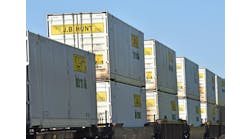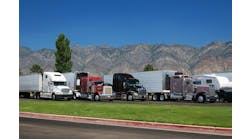Shipment growth rates for U.S. domestic packages* by mode
(*shipments weighing less than 70 pounds)
Shipment growth rates for U.S. domestic freight* by mode
(*shipments weighing 70 pounds or more)
Source: Colography Group Inc.
The recent economic recession in the U.S. forced businesses to re-examine shipping costs, resulting in a supply chain shift from national, centralized distribution to a regional, decentralized model, notes William Liddicoet, manager of applied research and analytical services for research and consulting firm Colography Group Inc. (www.colography.com). And it's been domestic air carriers that have most felt the pinch by this shift.
"Nearly 75% of the nation's freight travels 750 miles or less, distances that allow businesses to meet their delivery commitments by relying on regional truck services that cost less than air freight," Liddicoet explains.
"Shippers have definitely changed their buying patterns in terms of whether they need to ship overnight," agrees Brian Clancy, principal of consulting firm MergeGlobal Inc. (www.mergeglobal.com). "The catalyst has been that over the last 15 years [shippers] have become sensitized to the elements of value for which they pay. As express companies have made available a broader array of services, effectively what it unbundles some of the value shippers perceived in buying service."
Indeed, the three most visible movers of parcel by domestic air — FedEx Corp. (www.fedex.com), UPS Inc. (www.ups.com) and DHL (www.dhl.com) — are all showing growth in their service.
In the view of Dick Metzler, DHL America's executive vice president of marketing, it's the shorter haul, overnight shipments that are converting from air to ground, "where shippers are mode indiscriminant because of the distance." A shipment going from Miami to Jacksonville, for instance, won't be put on an airplane "since it would go on the same truck as a ground package and probably on the same delivery vehicle," Metzler says.
"Shippers have figured this out, especially those using parcel optimization solutions," he continues. "Increasinglyshippers are saying, 'For a four-pound package I can pay $21 for overnight, $12 for second-day and $4 for ground.' The only difference is time-ofday delivery."
Norm Black of UPS says that the carrier differentiates between its next-day air and deferred markets and for several years it has been growing its next-day air business faster than the market. In the last quarter, for example, UPS experienced a 4.1% increase in the next-day air market. Where last year UPS had an upsurge in air business, Black attributes that to letter traffic related to mortgage refinancing. This year UPS is experiencing its strongest growth in the package segment of its next-day air service.
"The deferred air segment is one that has slowed significantly," notes Black. "We certainly recognize mode shifts. The marketplace has increasingly become conditioned to the fact that our ground network is as reliable as our air network and that means the customer has the ability to decide what time the delivery is really needed. With the reliability offered by the ground product, it's possible to see people shifting to that segment."
For FedEx Express, domestic express package revenues were up 9% and its revenue per package increased by 7% in its most recent quarter, which the company attributes to three factors: higher fuel charge revenues, an increase in average weight per package and higher average rates per pound. The average daily package volume was up 1%.
As with others in the market, FedEx has experienced similar mode shifts away from air to ground services. FedEx foresees macroeconomic trends that will play into more business: Growth in hightech and high-value-added businesses, supply chain acceleration and growth of the Internet and e-commerce.
In looking at the state of the market, Colography's Liddicoet observes a steady decline in U.S. domestic air package from its peak in the late 1990s, while domestic ground parcel has remained rather strong even during weak economic times. Colography figures show ground parcel gained 8% of shipment shares since 2000, nearly all of the gain coming at the expense of domestic air.
Because the growth pace has remained steady since 2001, Liddicoet feels shippers have modal indifference. In forecasting the future, Colography predicts ground parcel business to have 175 million new shipments this year, while air shipments will continue to decline, year over year, with no end in sight to the trend.
"When people have to ship overnight, it's generally because they have to, not because they want to," points out MergeGlobal's Clancy. "So half the market is what we call 'emergency shipping,' meaning there is some time and place utility requirement in getting the product from A to B. The other half of the market is a little more discretionary and more price elastic. And that price elasticity has really not returned to air. What it's doing is moving the center of gravity from what used to be an overnight air market into, on average, more of a two-and-a-half-day market."
In observing trends, DHL's Metzler points to the growth in truckload multistop service coming to a halt with the new Hours of Service regulations. "What we've seen happen is more and more people have either gone to private fleet or premium less-than-truckload (LTL)," he says. "The LTL carriers are becoming more selective and that's pushing LTL into ground hundred weight. At that point, air can be less expensive than ground hundred weight, and even deferred air can be more economical, depending on weights and lanes and combinations."
From anywhere to everywhereHere's how the network designs of integrated carriers DHL, FedEx and UPS look:
Source: MergeGlobal Inc. |


